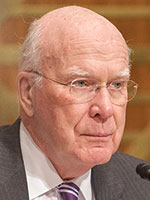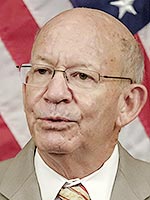Senior Reporter
Supply Chain, Midterms to Dominate Freight Policy in 2022

[Stay on top of transportation news: Get TTNews in your inbox.]
The implementation of last year’s $1 trillion infrastructure law, national elections in the fall and ongoing concerns regarding supply chain challenges and the omicron coronavirus variant will be front-and-center for policymakers heading into 2022.
Throughout the year, President Joe Biden’s administration is set to pursue myriad policy directives outlined in the Infrastructure Investment and Jobs Act, the sweeping law that took effect last November. For trucking, the bill paved the way for a truck-driving action plan meant to respond to an ongoing supply chain crisis at freight corridors.
Transportation Secretary Pete Buttigieg, Labor Secretary Marty Walsh and National Economic Council Director Brian Deese are leading that effort, which is part of a joint Cabinet-level initiative intended to spur job growth among driving careers.
At a December meeting at the White House among stakeholders, administration officials touted the industry’s contributions to respond to workforce concerns and efforts to alleviate supply chain bottlenecks. According to the White House on Dec. 16, “Several participants spoke of the high return on investment they had seen from creating registered apprenticeships, and the speed at which the Labor Department had approved new programs for their industry in recent months.”
Per the White House: “Industry participants discussed the steps they were taking to both recruit and retain a diverse workforce into the industry, from women to underrepresented minorities to veterans, and to create a safe and welcoming career path for these new drivers.”
Bill Sullivan, Executive Vice President of Advocacy at American Trucking Associations, applauded the steps the administration outlined in the new trucking action plan.
“We are encouraged that the Biden administration has not only recognized the importance of adding new and well-trained Americans to the trucking workforce, but has announced a path forward with what we believe will become a robust training opportunity for future commercial truck drivers,” said Sullivan.
“Using apprenticeships will help any American pursue a career in this great industry for good wages and benefits in a safe manner without the significant debt many job seekers can sometimes incur,” Sullivan added.
As part of the plan, regulators will be tasked with conducting a series of truck driver and industry listening sessions. The Federal Motor Carrier Safety Administration, an industry regulator, is examining predatory truck leasing arrangements, among other matters. The agency also is seeking to identify regulatory avenues meant to assist drivers and improve retention by raising the quality of certain jobs.

Joshi
This year, the administration will be in search of a new leader at FMCSA. Former FMCSA Deputy Administrator Meera Joshi — who was the agency’s acting administration — has accepted a senior position in the administration of New York City Mayor Eric Adams.
Before wrapping up her tenure at the agency in December, Joshi met with truck drivers in Charleston, S.C. At that event, FMCSA outlined efforts related to retention, wages, safe overnight parking and workforce concerns.
“It cannot be overstated how vital truck drivers are to every American family,” said Joshi. “As a nation, we count on truckers time and time again during crises. But truck drivers deserve not only our appreciation, but also our respect and support, including fair compensation, and safe and sufficient rest areas.”
On Capitol Hill, meanwhile, Democratic leaders remain determined to finalize the nearly $2 trillion climate change and social safety package titled the Build Back Better Act, the second tier of Biden’s infrastructure agenda. Senate Majority Leader Chuck Schumer (D-N.Y.) indicated he would ramp up negotiations to ensure passage of the spending bill.
Senate leaders had planned to wrap up the bill by Christmas, but Sen. Joe Manchin (D-W.Va.) said he could not continue negotiations in 2021 with the omicron variant of the coronavirus emerging as a growing threat. His vote is key to passing the budget package via a fast-track reconciliation procedure.
“The thing we should all be directing our attention toward is the variant, the COVID[-19] that we have coming back at us in so many different aspects in different ways,” Manchin told Fox News Sunday on Dec. 19. “It’s affecting our lives again. We have inflation that basically could harm — really harm — a lot of Americans, especially those who are most needy and having a hard time struggling right now.”
Manchin added, “This is a ‘no’ on this legislation. I have tried everything I know to do, and the president has worked diligently. He’s been wonderful to work with. He knows I’ve had concerns and the problems I’ve had.”
Pushing back on Manchin’s stance were fellow Democrats, specifically members of the progressive bloc. They pressed the moderate senator and the White House to remain focused on the Build Back Better agenda in 2022.
As Rep. Pramila Jayapal (D-Wash.), chairwoman of the Progressive Caucus, put it, “In Congress, we will continue to prioritize a legislative path for Build Back Better, focused on taking the current text of the legislation passed by the House, keeping as much of it as possible — but no less than the elements contained in the framework negotiated by the president and committed to by Senators Manchin and [Kyrsten] Sinema some months ago.”
She continued, “We have worked too long and too hard to give up now, and we have no intention of doing so.”
As it pertains to transportation policy, the Build Back Better Act would dedicate $600 million for Maritime Administration projects meant to alleviate supply chain congestion at ports. The U.S. Department of Transportation would receive $300 million to develop and apply low-emission aviation technologies. And the National Highway Traffic Safety Administration would receive nearly $50 million for states to ensure equity in traffic enforcement.

Leahy
While the Democratic infighting over the social infrastructure budget continues, Biden is contending with job approval ratings in the 40% range. Against this backdrop, Congress is facing a February funding deadline for fiscal 2022 bills. Senate Appropriations Committee leaders signaled optimism over the possibility of agreeing on a framework for this spending, as committee chairman Patrick Leahy (D-Vt.) has been pressing Republicans to negotiate on spending allocations and policy proposals.
The government is operating on a short-term funding law that expires Feb. 18.
“The Republican leadership needs to step up and engage, and they need to do it in the next few weeks. Otherwise we will be right back here on Feb. 18,” Leahy said ahead of the chamber’s approval of the stopgap legislation. Top committee Republican Sen. Richard Shelby of Alabama also called on colleagues to work on the spending bills.
“I have said many times that work can only begin if we agree to start [fiscal year] ’22 where we finished [fiscal year] ’21,” Shelby said in December. “That means maintaining legacy riders, eliminating poison pills and getting serious about the funding we are going to provide for our nation’s defense. If that doesn’t happen, we’ll be having this same conversation in February.”
On matters related to supply chain bottlenecks, the White House and senior Biden administration officials expect that freight bottlenecks would continue in 2022. A White House task force, created to work with private sector firms to facilitate movement of containers at ports, plans to keep dedicating funds for connectivity initiatives.
Biden communicated with the task force on Dec. 22: “Right now, the number of containers moving through our ports is higher than ever,” he said. “When I sat down and talked with the folks running the ports and the longshoremen, they agreed to speed up every step in the process: the ports, the trains, the trucking.”
Biden noted that there is $17 billion included in the infrastructure bill to “speed up and modernize our ports.”
The midterm elections in November also are part of this year’s agenda. Congressional and political observers, anticipating a shift in the balance of power in Washington, point to a growing number of Democrats not seeking re-election.
Last month, Rep. Stephanie Murphy (D-Fla.) announced that, after a few terms in office, she will retire from the House in 2022. That made her the 23rd House Democrat to announce an exit from Congress.

DeFazio
Murphy joined a growing list of swing district moderates who won’t return to Capitol Hill. Other notable Democratic retirements include Transportation Committee member Rep. Albio Sires (D-N.J.), transportation appropriations subcommittee Chairman David Price (D-N.C.), and transportation committee Chairman Peter DeFazio (D-Ore.).
For his part, DeFazio in December touched on 2022: “I still have a lot of work to do in my remaining 13 months and I’ll be putting all of my efforts into that work, including helping to pass the Build Back Better Act that will bring down costs for families, create jobs, fight the climate crisis and help Americans get ahead,” he said.
House Minority Leader Kevin McCarthy (R-Calif.) has said the wave of retirements before the 2022 midterms is a good sign for the GOP. A likely choice to lead the chamber in a Republican takeover, McCarthy is expected to continue to raise concerns over the current agenda: “As Democrats continue to push counterproductive policies that will only mean higher costs for Americans, Republicans will fight back against Biden’s flawed agenda, while we continue to push for policies that support American workers and small businesses,” he has said.
In the U.S. Senate, open-seat races in North Carolina and Pennsylvania have gained greater relevance as each party seeks to win control. The Cook Political Report with Amy Walter rated the contests as “toss-ups.” And candidates to watch include Lt. Gov. John Fetterman for Democrats in Pennsylvania and former Republican Gov. Pat McCrory in North Carolina.
On the policy front, FMCSA is expected to continue to demonstrate regulatory flexibility amid coronavirus concerns.
https://t.co/RwEFtvyKZk @OOIDA @truckingdotorg#truckstatistics #truckusage #truckcharacterisitcs #nationaldata #fuelusage #trucktechnologies #americantransportationresearchinstitute #nationalprivatetruckcouncil pic.twitter.com/w5iwTBx4pP — TransportStats (@TransportStats) November 15, 2021
Separately, starting in February the Bureau of Transportation Statistics, or BTS, will begin collecting surveys of commercial drivers. The information is meant to elucidate trends for agencies, as well as the freight sector and other industries. Per BTS, the Vehicle Inventory and Use Survey, or VIUS, will “gain an understanding nationally and statewide on how trucks are being utilized for various goods transport.”
Want more news? Listen to today's daily briefing below or go here for more info:




